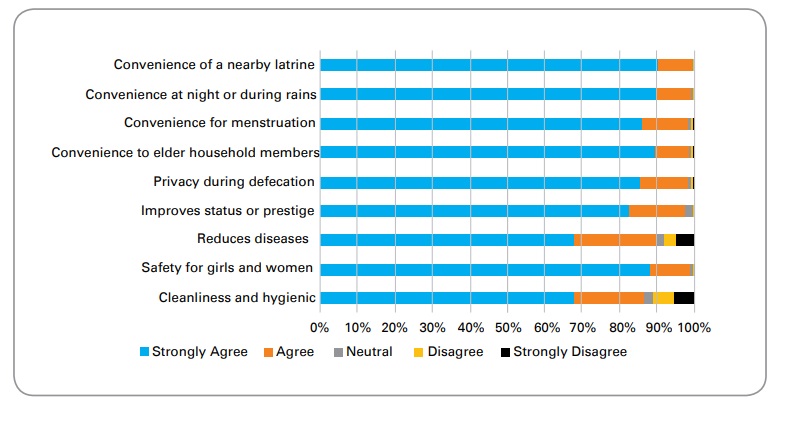It is rightly said that “Healthy Body results in a Healthy mind which is directly proportional to the Productivity of an individual.” So, to prevent diseases, it’s of utmost importance to maintain the right cleanliness, sanitation, and hygiene at the household as well as community level. Unfortunately, the quality of hygiene and cleanliness maintained by people in India was not up to the mark and it was a common sight to see open garbage dumps, overflowing drains, and open defecation in many places.
Every individual was keeping their home clean but no one was bothered to maintain the cleanness of outside surroundings. The data from a UN Report illustrated that nearly 60% of India’s population, especially in rural areas used to practice open defecation as they did not have toilet facilities which put them at risk of diseases like cholera, diarrhea, and typhoid. Not just this, millions of deaths in India were reported in previous years due to diseases resulting from poor sanitation and hygiene. From a monetary aspect, lack of cleanliness used to lead to an annual loss of over Rs 6500 every year to each Indian which was spent on healthcare costs.
There was an urgent need to employ proper sanitation methods and maintain good hygiene at both personal and community levels in order to improve health of masses. This led to the launch of Swachh Bharat Abhiyan (Clean India Mission) that was launched as a national movement by Prime Minister Narendra Modi in 2014 with the target to make India open defecation free (ODF), ensure proper waste management and cleaning of streets and roads along with educating people on the importance of cleanliness.
Key Objectives of Swachh Bharat Abhiyan
- Elimination of manual scavenging by ensuring door to door collection of waste, its segregation and proper disposal.
- Make India open defecation free by constructing hygienic sanitary toilets.
- Inculcate modern and scientific techniques for managing municipal solid waste.
- Spread awareness about the waste management and to augment the capacity of urban local bodies to ensure their proper functioning and cleanliness
- Construction of nearly 90 million toilets in rural areas till the end of Swachh Bharat Mission on 2nd October 2019
- Spread awareness among the villagers and motivating panchayats to participate actively in the cleanliness campaigns.
With an aim to make India cleaner and greener, the campaign of Swachh Bharat was formulated to cover all the cities and towns of India with a special emphasis on rural areas. Taking the lead, Prime Minister Narendra Modi kicked off the campaign from Delhi by picking up the broom himself and initiating the cleanliness drive. He invited the other citizens to join him in this initiative and exhorted people to devote 100 hours every year towards the cause of cleanliness.
Such was the impact of his words and action that millions of people of various cadres such as government officials, jawans, sportspersons, industrialist, spiritual leaders, and various NGO came forward and joined this mass movement. Citizens turned out in large numbers in their cities to take this journey forward. Their selfless act was applauded by government and “#MyCleanIndia” was created on social media channel twitter to highlight the cleanliness work carried out by citizens and motivate others to join this mass movement.
People drove in huge numbers and pledged to make India neat and clean and making this initiative a success story. There was a sense of ownership in every individual to maintain the cleanness in their respective cities which was well supported by the government. This was further strengthened by the government providing financial support to the marginalized people to enable faster toilet construction, especially in rural areas.
The Swachh Bharat Mission objectives were accomplished on time and as an outcome of this mission, India was able to declare itself “open-defecation free (ODF) by 2019. As a part of this initiative, more than 60 lac individual household toilets and 6 lac community and public toilet were constructed across the country.
One of the international study around benefit analysis showed that the Swachh Bharat Mission is highly cost-beneficial from both a financial and an economic perspective. For any household that invest INR 16,000 (US $248) of their own money in a toilet and handwashing station, they will see those funds repaid in 2 years from the medical costs saved.
In addition to this, the benefits accrued per household from having a household toilet and using it are:
- Medical costs averted: financial savings from paying less medical costs based on reductions in illness episodes
- Value of time savings: reduced time lost from sickness and seeking a place for open defecation
- Value of saved lives: economic value of saved lives due to lower mortality rates
- Property value: the average increase in property value from having a toilet

The study also published the intangible benefits of owning a toilet as perceived by households:

To give further boost to this initiative, Swachh Survekshan Survey 2019 was done by the Ministry of Housing and Urban Affairs that ranked the cities on the cleanliness index and they were awarded the ratings of GFC (Garbage Free Cities). More than 200 cities got 3 Star or above rating in this ranking which clearly showcases the success of this mass movement.
With respect to waste management, around 152.24 k+ TPD (tonnes per day) waste was generated out of which 114.23 k+ TPD (tonnes per day) was processed effectively which is a big milestone that has been achieved through the Swachh Bharat Mission.
Swachh Bharat Mission had a transformational impact on the way sanitation is perceived by people and to extend its outreach, second phase of flagship Swachh Bharat Mission was launched in 2021 to ensure effective solid and liquid waste management in every panchayat thus resulting into fool proof waste management. In addition to this, the new target of constructing 350,000 individual, community and public toilets was set up to bring about social changes in society around hygiene and cleanliness.
Not only this, as a part of Swachh Bharat Mission Urban 2.0, technology based digital innovations were used to facilitate and engage people to be an active contributor in this initiative. Swachhata App was launched that enable the citizens to log complaint if they have any issues with the sanitation in their localities, SBM Toilet Locator on Google Maps was created to improve accessibility of public toilets and My Toilet Facility App was launched that is used by caretakers of the toilets where caretakers log their attendance and seek feedback from the users so that cleanliness of community toilets and public toilets can be ensured.
India has come a long way from processing of barely 20% of its daily waste before 2014 to about 70% in 2021 and the target is to make it 100%. Under PM Modi’s leadership, maintaining cleanliness and hygiene has become a collective responsibility of all citizens and that is clearly visible with the success that has been achieved through Swachh Bharat Abhiyan.
An initiative started by PM Modi became a mass movement with active participation of people from all spheres and that day is not far when India will be a leading force in helping other nations to implement efficient waste management and sanitation in their countries to improve their standards of living.
References








